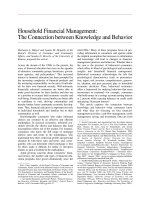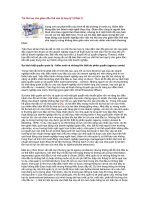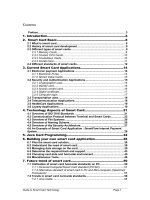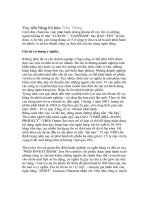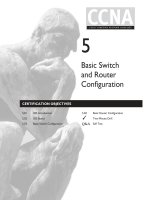Tài liệu BASIC FINANCIAL ACCOUNTING: SYLLABUS CONTENT doc
Bạn đang xem bản rút gọn của tài liệu. Xem và tải ngay bản đầy đủ của tài liệu tại đây (523.69 KB, 35 trang )
Chapter
3
Basic Financial
Accounting
Syllabus Content
Accounting systems – 20%
Ledger accounts; double-entry bookkeeping.;
D - Preparation of accounts – 45%
Trading, profit and loss accounts and balance sheets from trial balance; accounting for the
appropriations of profit.
1
Financial statements are produced to give information to the users. As mentioned earlier the
most important financial statements are the income statement and balance sheet. These are
prepared under the separate entity concept.
The separate entity concept means the business is treated separately from its owners. This
applies to sole traders, partnerships and incorporated companies.
3.1 The Balance sheet
The top half of the balance sheet shows all the assets owned by the business. The assets are
either non current or current.
The bottom half off the balance sheet shows capital, reserves and liabilities. The liabilities are
either non current or current.
Items in balance
sheet
Description Examples
Non current assets
These are long term assets used
to generate profit. The business
will hold on to these assets for
more than one year.
Land & buildings, plant &
machinery, fixtures & fittings
and motor vehicles
Current assets
Short-term assets used for the
day-to-day operations. These
assets are for less than one year.
Inventories, trade receivables
and cash
Non current
liabilities
These are long term liabilities
over one year which are owed
to third parties.
Long term bank loans
Current liabilities
These are liabilities owed to
third parties but which are due
in less than one year’s time
Trade payables, taxation and
bank overdraft.
Capital
This is what the owners have
put into the business as
investment, and therefore are
owed by the entity.
Share capital or cash. Owners
can withdraw capital and this is
known as drawings. Dividends
for incorporated entities.
Accumulated profit
or loss (Reserves)
This is the profit or loss that the
business has made. It belongs
to the owners.
Income – Expenses = profit or
loss
2
The income statement shows all the revenue or income generated for the period
less all expenses
arriving at the period’s profit or loss.
3.2 Accounting Equation
In the balance sheet the assets of the business are equal to the liabilities.
Net assets are total assets less total liabilities. The net assets equal the capital and reserves in the
balance sheet. The capital and reserves is also known as the “proprietors’ funds or Shareholders’
funds”.
Therefore putting this into an equation, we get:
Assets – Liabilities = Capital + Profits – Losses – Drawings
OR
Nets Assets = proprietors’ funds or Shareholders’ funds
Assets are positive figures on the balance sheet. Liabilities and capital are negative figures. We
can now re-arrange the accounting equation as follows:
Assets = Capital + Profits – Losses - Drawings + liabilities
Or
Assets = proprietors’ funds + liabilities
Worked Example
1 Introduction of Capital
Kitten sets up a new business selling designer makeup at low prices. The new business is called
“Beauty Within”
She puts £20,000 cash into the business.
This is how it effects the accounting equation
Assets = Proprietors’ funds + Liabilities
Cash 20,000 Introduced 20,000
Total 20,000 20,000
£20,000 is a current asset in the form of cash, and this is what Beauty Within owes to Kitten.
Beauty Within is a separate entity.
3
2 Purchase of Assets
Kitten now buys a shop to sell the makeup from. The shop costs £10,000, and is paid for in cash.
Kitten also purchases £5,000 worth of makeup in cash from a special dealer that she has contacts
with.
This is how the above transactions effect the accounting equation.
Assets = Proprietors’ funds + Liabilities
Shop 10,000 Introduced 20,000
Inventory 5,000
Cash 5,000
Total 20,000 20,000
3 Sale of inventory
Kitten who is a very shrewd sales woman has managed to sell all her stock of makeup to a
television company for £8,000 in cash. This means a profit of £3,000 has been made (£8,000 –
5,000). This profit belongs to the owner therefore is part of the capital.
This is how the above transactions effect the accounting equation.
Assets = Proprietors’ funds + Liabilities
Shop 10,000 Introduced 20,000
Inventory 0 Profit 3,000
Cash 13,000
Total 23,000 23,000
4 Drawings
Kitten requires some cash for her personal use. She withdraws £500 from the business.
This is how the above transactions effect the accounting equation.
Assets = Proprietors’ funds + Liabilities
Shop 10,000 Introduced 20,000
Inventory 0 Profit 3,000
Cash 12,500 Drawings (500)
Total 22,500 22,500
4
Note that drawings are taken out by the owner therefore it does not affect the profit figure (ie it is
not an expense).
5 Expenses of the business
Kitten has to pay some utility bills that are due for the shop. These amount to £300 in total and
Kitten pays them in cash.
This is how the above transactions effect the accounting equation.
Assets = Proprietors’ funds + Liabilities
Shop 10,000 Introduced 20,000
Inventory 0 Profit 2,700
Cash 12,200 Drawings ( 500)
Total 22,200 22,200
Note that the business expenses have reduced the profit {£3,000 - £300} and reduced the cash by
£300.
6 Purchases on Credit
Kitten now purchases more makeup, but this time buys them on credit for one month. Stock
worth £3,000 has been purchased this way.
This means that the business owes money, so therefore there is a liability in the form of trade
payables.
This is how the above transactions effect the accounting equation.
Assets = Proprietors’ funds + Liabilities
Shop 10,000 Introduced 20,000 Trade payables 3,000
Inventory 3,000 Profit 2,700
Cash 12,200 Drawings (500)
Total 25,200 22,200 3,000
5
7 Sale on Credit
Kitten has found a buyer for her entire stock of makeup for £5,000, but the sale is made on
credit, meaning that the buyer will pay for the goods in 2 months time (trade receivables).
This is how the above transactions effect the accounting equation.
Assets = Proprietors’ funds + Liabilities
Shop 10,000 Introduced 20,000 Trade payables 3,000
Inventory 0 Profit 4,700
Trade receivables 5,000 Drawings (500)
Cash 12,200
Total 27,200 24,200 3,000
The business has made a profit of £2,000 {£5,000 - £3,000}. Therefore the total profit now
stands at £4,700.
8 Settlement of trade receivables and trade payables
The trade payables get paid and the trade receivables send a cheque to Kitten.
This is how the above transactions effect the accounting equation.
Assets = Proprietors’ funds + Liabilities
Shop 10,000 Introduced 20,000 Trade payables 0
Inventory 0 Profit 4,700
Trade receivables 0 Drawings (500)
Cash 14,200
Total 24,200 24,200 0
6
This is how the balance sheet will appear after the last transaction
Balance sheet of Beauty Within
Non current assets
Shop 10,000
Current assets
Cash 14,200
Total assets 24,200
Capital and reserves (or proprietors’ funds)
Capital 20,000
Drawings (500)
Profit 4,700
24,200
Current liabilities 0
Total capital, reserves and liabilities
24,200
3.3 Double Entry
As you can see from the above examples regarding the accounting equation, a single transaction
has a “dual effect” on the equation.
For example, introduction of the capital:
1 Cash increased by £20,000 = increase in assets
2 Capital increased by £20,000 = increase in capital
Another example is expenses of the business:
1 Cash decreased
2 Profit also decreased.
This is not a coincidence; it’s actually a method of accounting, known as
Double Entry
.
With double entry every transaction has a dual effect. This is ALWAYS the case.
We shall come back to double entry later, but first let’s have a look at some other basics.
7
Revenue and capital expenditure
Revenue expenditure affects the income statement and is expensed in the period it is incurred.
Revenue expenditure includes wage expenses, rent payments and utility expenses. Revenue
expenditure is also known as period expenses.
Capital expenditure is taken to the balance sheet and doesn’t affect the profit and loss for the
period. Capital expenditure includes buying non current assets. Capitalisation means taking
items to the balance sheet.
3.4 Recording transactions
A business will need to record every transaction relating to its business.
Source Documents
These are the initial documentation, which show the
source of information needed to record financial
information. Examples include invoices, sales orders,
payslips etc.
Books of Prime Entry
This is where the source documents are recorded at the
first stage of the accounting system. Examples include
sales daybook, purchase daybook, cashbook etc.
Ledger Accounts (nominal or
general ledger)
The ledger contains accounts for assets, liabilities,
capital, income and expenditure. These individual
accounts record all the transactions.
3.5 Ledger Accounting
The general ledger is the heart of the accounting system. It contains a separate account for each
item that appears in the balance sheet and income statement. Most ledgers are now computerised
eg SAGE, QuickBooks. Each account is given a code, which may comprise of numbers, text or
both.
A ledger account has “TWO” sides to it. Below is an example of what a ledger account looks
like for a non current asset account.
Non current assets
Date Description £
D
D
E
E
B
B
I
I
T
T
Date Description £
C
C
R
R
E
E
D
D
I
I
T
T
8
This is often referred to as a “T” account.
The “TWO” sides allow the double entry to be recorded. The left hand side is the “DEBIT” and
the right hand side is the “CREDIT”.
The history of debits and credits dates back to the 15
th
century!!
3.6 Rules for Double Entry
F
F
o
o
r
r
e
e
v
v
e
e
r
r
y
y
d
d
e
e
b
b
i
i
t
t
t
t
h
h
e
e
r
r
e
e
i
i
s
s
a
a
n
n
e
e
q
q
u
u
a
a
l
l
c
c
r
r
e
e
d
d
i
i
t
t
Every transaction will give rise to two accounting entries, a debit and a credit. Because of this
basic fundamental rule, it means that all the debits and all the credits in the ledger will be equal.
A useful matrix may help in understanding double entry:
Event Financial statement Debit or Credit
Increase in assets
Balance sheet
Debit
Decrease in assets Balance sheet Credit
Increase in liability Balance sheet Credit
Decrease in liability Balance sheet Debit
Increase in capital Balance sheet Credit
Decrease in capital Balance sheet Debit
Increase in revenue Income statement Credit
Decrease in revenue Income statement Debit
Increase in expense Income statement Debit
Decrease in expense
Income statement Credit
Another way of remembering the double entry rule is:
An Asset
Debit
Elephant
Expenses Debit
Is
Income / Revenue Credit
Lumpy
Liabilities Credit
9
In the income statement, the revenue items like sales are credits in the ledger. Expenses are
debits.
Income statement
Increase
in
revenues
Increase
in
expenses
C
C
R
R
E
E
D
D
I
I
T
T
D
D
E
E
B
B
I
I
T
T
All decreases are opposites
In the balance sheet, debits are assets and credits are liabilities and capital.
Balance sheet
Increase in
Capital
Increase in
liabilities
Increase in
assets
D
D
E
E
B
B
I
I
T
T
C
C
R
R
E
E
D
D
I
I
T
T
C
C
R
R
E
E
D
D
I
I
T
T
All decreases are opposites
10
3.7 Journal Entries
Entries to the ledger are made through journal entries. This is simply writing out the amount, the
account code, description and whether it’s a debit or credit entry.
For Example
Date Account Code Account Name Description Debit £ Credit £
1/1/X5
100353 Non current
assets
Purchase of machine 10,000
1/1/X5 100454 Bank Cheque 35 10,000
For exam purposes you can simply write out the journal entry as follows:
Dr Non current asset £10,000
Cr Bank £10,000
It is also useful in the exam to write out which financial statement it affects. So for the above
example, both fixed asset and bank are Balance Sheet (BS) items.
Dr Non current asset (BS) £10,000
Cr Bank (BS) £10,000
Going back to our example of Kitten, the transactions will affect the ledger accounts as follows:
1 Introduction of Capital
Kitten sets up a new business selling designer makeup at low prices. The new business is called
“Beauty Within”. She puts £20,000 cash into the business.
Journal entry
Debit (Dr) Bank £20,000
Credit (Cr) Capital £20,000
11
T accounts
Capital Account
Cash Introduced £20,000
Bank Account
Capital introduced £20,000
Account Equation
Assets = Proprietors’ funds + Liabilities
Bank 20,000 Introduced 20,000
Total 20,000 20,000
2 Purchase of Assets
Kitten now buys a shop to sell the makeup from. The shop costs £10,000, and is paid for in cash.
Kitten also purchases £5,000 worth of makeup in cash from a special dealer that she has contacts
with.
Journal Entry
Dr Non current asset – Shop (BS) £10,000
Dr Inventory (BS) £ 5,000
Cr Bank (BS) £15,000
T Accounts
Non current asset - Shop
Shop bought with cash £10,000
Inventory
Stock bought with cash £5,000
Bank Account
Capital introduced £20,000
Non current asset - Shop £10,000
Inventory £ 5,000
12
Accounting Equation
Assets = Proprietors’ funds + Liabilities
Shop 10,000 Introduced 20,000
Inventory 5,000
Bank 5,000
Total 20,000 20,000
3 Sale of inventory
Kitten who is a very shrewd sales woman has managed to sell all her stock of makeup to a
television company for £8,000 in cash. This means a profit of £3,000 has been made (£8,000 –
5,000). This profit belongs to the owner therefore is part of the capital.
Journal entry
1 Record the sale
Dr Bank (BS) £8,000
Cr Sales (IS) £8,000
2 Adjust for the inventory
The inventory has now been sold, so it needs to be removed from the balance sheet.
Dr Cost of sales (IS) £5,000
Cr Inventory (BS) £5,000
The net affect to the income statement is £3,000, which is the profit earned from the sale.
T accounts
Sales
Sale of makeup in cash £8,000
Bank Account
Capital introduced £20,000
Sale of makeup £ 8,000
Non current asset - Shop £10,000
Inventory £ 5,000
13
Cost of Sales
Inventory £ 5,000
Inventory
Inventory bought with cash £5,000 Cost of sales £5,000
Accounting Equation
Assets = Proprietors’ funds + Liabilities
Shop 10,000 Introduced 20,000
Inventory 0 Profit 3,000
Bank 13,000
Total 23,000 23,000
4 Drawings
Kitten requires some cash for her personal use. She withdraws £500 from the business.
Journal entry
Dr Drawings (BS) £500
Cr Bank (BS) £500
T accounts
Drawings
Bank £ 500
Bank Account
Capital introduced £20,000
Sale of makeup £ 8,000
Non current asset - Shop £10,000
Inventory £ 5,000
Drawings £ 500
14
Accounting Equation
Assets = Proprietors’ funds + Liabilities
Shop 10,000 Introduced 20,000
Inventory 0 Profit 3,000
Bank 12,500 Drawings (500)
Total 22,500 22,500
5 Expenses of the business
Kitten has to pay some utility bills that are due for the shop. These amount to £300 in total and
Kitten pays them in cash.
Journal Entry
Dr Utility Expenses (IS) £300
Cr Bank (BS) £300
T accounts
Utility Expenses
Bank £ 300
Bank Account
Capital introduced £20,000
Sale of makeup £ 8,000
Non current asset - Shop £10,000
Inventory £ 5,000
Drawings £ 500
Utility Expenses £ 300
Accounting Equation
Assets = Proprietors’ funds + Liabilities
Shop 10,000 Introduced 20,000
Inventory 0 Profit 2,700
Bank 12,200 Drawings (500)
Total 22,200 22,200
Note that the business expenses have reduced the profit {£3,000 - £300} and reduced the cash by
£300.
15
6 Purchases on Credit
Kitten now purchases more makeup, but this time buys them on credit for one month. Inventory
worth £3,000 has been purchased this way.
This means that the business owes money, so therefore there is a liability in the form of trade
payables.
Journal entry
Dr Inventory (BS) £3,000
Cr Trade Payables (BS) £3,000
T accounts
Inventory
Inventory bought with cash £5,000
Inventory bought on credit £3,000
Cost of sales £5,000
Trade Payables
Inventory bought on credit £3,000
Accounting Equation
Assets = Proprietors’ funds + Liabilities
Shop 10,000 Introduced 20,000 Trade payables 3,000
Inventory 3,000 Profit 2,700
Bank 12,200 Drawings (500)
Total 25,200 22,200 3,000
16
7 Sale on Credit
Kitten has found a buyer for her entire stock of makeup for £5,000, but the sale is made on
credit, meaning that the buyer will pay for the goods in 2 months time (trade receivables).
Journal entry
1 Record the sale
Dr Trade receivables (BS) £5,000
Cr Sales (IS) £5,000
2 Adjust for the inventory
The inventory has now been sold, so it needs to be removed from the balance sheet.
Dr Cost of sales (IS) £3,000
Cr Inventory (BS) £3,000
The net affect to the income statement is £2,000, which is the profit earned from this sale.
T accounts
Sales
Sale of makeup in cash £8,000
Sale of makeup on credit £5,000
Trade receivables
Sale £ 5,000
Cost of Sales
Stock £ 5,000
Stock £ 3,000
Inventory
Inventory bought with cash £5,000
Inventory bought on credit £3,000
Cost of sales (cash) £5,000
Cost of sales (credit) £3,000
17
Accounting Equation
Assets = Proprietors’ funds + Liabilities
Shop 10,000 Introduced 20,000 Trade payables 3,000
Inventory 0 Profit 4,700
Trade receivables 5,000 Drawings (500)
Bank 12,200
Total 27,200 24,200 3,000
The business has made a profit of £2,000 {£5,000 - £3,000}. Therefore the total profit now
stands at £4,700.
8 Settlement of trade receivables and trade payables
The trade payables get paid and the trade receivables send a cheque to Kitten.
Journal entry
1 Payment to the trade payables
Dr Trade payables (BS) £3,000
Cr Bank (BS) £3,000
2 Cheque received from trade receivables
Dr Bank (BS) £5,000
Cr Trade receivables (BS) £5,000
T accounts
Trade payables
Bank £3,000 Inventory bought on credit £3,000
Trade receivables
Sale £ 5,000
Bank £5,000
Bank Account
Capital introduced £20,000
Sale of makeup £ 8,000
Trade receivables £ 5,000
Non current asset - Shop £10,000
Inventory £ 5,000
Drawings £ 500
Utility expenses £ 300
Trade payables £ 3,000
18
Accounting Equation
Assets = Proprietors’ funds + Liabilities
Shop 10,000 Introduced 20,000 Trade payables 0
Inventory 0 Profit 4,700
Trade receivables 0 Drawings (500)
Bank 14,200
Total 24,200 24,200 0
3.8 Balancing and closing the ledger accounts
At the end of the accounting period, after all the transactions have been entered, the ledger
accounts are balanced and closed off.
All the debits are totalled and so are all the credits. Both sides must equal each other, and
therefore a “balancing figure” is entered to ensure they equal.
Balance sheet
The balancing figure is “carried forward” into the next period. Then in the next period, this
balancing figure is known as the “bought forward”. This is done for assets, liabilities and
capital.
Income statement items
The balancing figure in all the income statement items are transferred into a new ledger account
called the
profit and loss ledger account
or trading, profit and loss ledger account. Double
entry is used to transfer all income and expenses into this account, (which appears in the final
balance sheet under capital). The profit and loss ledger account is the accumulation of all profits
and losses since trading began and is a balance sheet account. The income statement accounts
(all expenses and revenues) are re-set to zero for the next accounting period.
19
Balancing off Kittens accounts
Profit and loss accounts
Sales
P&L Ledger account £13,000
(balancing figure)
Total
£13,000
Sale of makeup in cash £8,000
Sale of makeup on credit £5,000
Total
£13,000
Cost of Sales
Inventory £ 5,000
Inventory £ 3,000
Total
£ 8,000
P&L Ledger account £ 8,000
(balancing figure)
Total £ 8,000
Utility Expenses
Cash £ 300
Total
£ 300
P&L Ledger account £ 300
(balancing figure)
Total £ 300
Balance sheet Accounts
Trade payables
Payment £3,000
Total
£3,000
Inventory bought on credit £3,000
Total
£3,000
Trade receivables
Sale £ 5,000
Cash £5,000
Total
£5,000
Total £5,000
20
Cash Account
Capital introduced £20,000
Sale of makeup £ 8,000
Trade receivables £ 5,000
Non current asset - shop £10,000
Inventory £ 5,000
Drawings £ 500
Total
£33,000
Utility Expenses £ 300
Trade payables £ 3,000
Balance c/f £14,200
Total
£33,000
Inventory
Inventory bought with cash £5,000
Inventory bought on credit £3,000
Total
£ 8,000
Cost of sales (cash) £5,000
Cost of sales (credit) £3,000
Total
£ 8,000
Non current asset - Shop
Shop bought with cash £10,000
Total
£10,000
Balance c/f £10,000
Total £10,000
Capital Account
Balance c/f £20,000
Total
£20,000
Cash Introduced £20,000
Total
£20,000
Drawings
Cash £ 500
Total
£ 500
Balance c/f £ 500
Total
£ 500
The profit and loss ledger account is opened to take in the entries from the closing off the income
statement items
21
Profit and Loss ledger account
Cost of sales £8,000
Utility Expenses £ 300
Balance c/f £4,700
Sales £13,000
Total
£13,000
Total £13,000
Note the profit is the same as in the accounting equation
Understanding the “carried forward”
The carried forward figures in the balance sheet accounts are the opening balances for the next
period.
For example the carried forward of the cash account is £14,200, this will then be “bought
forward (b/f)” in the next period as follows:
Cash Account
Balance b/f £14,200
Note how the b/f balance is on the opposite side of the carried forward. This is always the case,
as the balancing item of £14,200 represents the fact that the debits exceed credits from the last
period.
Therefore balances c/f on the credit side are debit balances when b/f (assets). And balances c/f
on the debit side are credit balances when b/f (liability).
Always try to think in terms of whether it’s an asset or liability. With the cash account, we have
received more money than paid out, so it must mean that we have a positive bank balance. This
is represented by the debit balance of £14,200 (remember debits on balance sheet is an asset).
22
3.9 The Trial Balance
A trial balance is created, which is simply a list of all the ledger accounts and their balances. It is
used to prepare the financial statements.
For Kitten the trial balance will look something like this:
Account name Debit Credit
Sales 13,000
Cost of Sales 8,000
Utility expenses 300
Cash account 14,200
Non current asset 10,000
Capital 20,000
Drawings 500
Total 33,000 33,000
Note how there are no accounts for inventory, trade receivables and trade payables. This is
because the balances’ on these accounts are zero as they have all been cleared at the period end,
(ie all inventories have been sold, trade receivables have paid up and trade payables are settled).
Note how the accounting equation, the balances on the T accounts and the trial balance all tie in.
23
3.10 Preparing the financial statements
The income statement and balance sheet can now be prepared from the trial balance.
Income statement for Kitten for the current period £
Sales 13,000
Less cost of sales (8,000)
Gross Profit 5,000
Less expenses
Utility expenses (300)
Net profit 4,700
Balance sheet for Kitten as at the end of the period
£
Non current assets 10,000
Current assets
Cash 14,200
Total assets
24,200
Capital and reserves
Capital 20,000
Drawings (500)
Profit 4,700
24,200
Liabilities 0
Total capital, reserves and liabilities
24,200
24
3.11 Capital, drawings and Profit & loss ledger account
There are a few final adjustments that need to be done to complete the double entry system. The
proprietor’s capital consists of any cash introduced by them, plus any profits (less losses) and
less any drawings.
Let’s now transfer the balances from the drawings account and P&L ledger account into the
capital account. This is only done for sole traders and partnership accounts, not for incorporated
entities.
Drawings
Cash £ 500
Total
£ 500
Transfer to capital a/c £ 500
Total
£ 500
Profit and Loss ledger account
Cost of sales £8,000
Utility Expenses £ 300
Transfer to capital a/c £4,700
Sales £13,000
Total
£13,000
Total £13,000
Capital Account
Drawings £ 500
Balance c/f £24,200
Total
£24,700
Cash Introduced £20,000
Profit and loss ledger a/c £ 4,700
Total
£24,700
The balance sheet can now be shown as follows:
Non current assets 10,000
Current assets
Cash 14,200
Total assets
24,200
Proprietors’ capital 24,200
Liabilities 0
Total proprietors’ capital and liabilities
24,200
Note: Capital b/f
25
